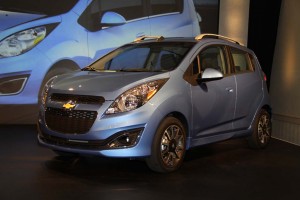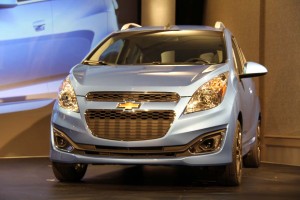
Chevrolet will offer both a battery version of the new spark and a conventional gas model using an all-new engine family.
General Motors will introduce its first pure battery-electric vehicle, or BEV, sometime in 2013, basing it off the next-generation Chevrolet Spark platform.
The Spark EV initially will be sold in “select” urban markets around the world, including Southern California. It will then roll out to other parts of the world, with GM officials anticipating a slow ramp-up of demand for the vehicle – and for electric vehicles in general.
The Spark minicar will also be among the first GM models to make use of an all-new line of 3- and 4-cylinder Ecotec engines GM plans to bring to market in an effort to both improve fuel-efficiency and expand its own economies of scale,
Demand for the new Spark battery car “will be slow,” acknowledged Jim Federico, GM’s small car engineering chief, as “Customers need to get comfortable and used to” the new technology. Nonetheless, GM officials said they recognize that the global push for cleaner, higher-mileage products will require the expanded use of “electrification” in all its various forms.
GM has already begun a high-profile push into electric propulsion. It recently expanded production of its Chevrolet Volt plug-in electric vehicle and is just launching it in a number of new U.S. markets, as well as in Europe – where the near-twin Opel Ampera will also be offered. Meanwhile, a mild hybrid version of the 2012 Buick Lacrosse is now making its debut, with the so-called eAssist driveline set to also be offered in the next-generation Chevrolet Malibunotably .
The automaker declined to provide specific details about the new Spark EV, including range, but officials confirmed an earlier report in TheDetroitBureau.com that the new BEV will make use of a new generation of lithium-ion batteries provided by U.S. supplier A123.
Though both the Spark and Volt will share the use of lithium-ion technology, their batteries use different chemistries. In Volt, which has a back-up gasoline engine, the emphasis is on delivering both a mix of performance and range using a battery provided by South Korea’s LG Chem.
In the new Chevrolet Spark EV, range trumps all, so its A123 battery puts a premium on what is known as energy density.
The good news is that the latest lithium batteries are significantly improving the amount of energy they can store, several GM sources have indicated, which means they are lighter and can be packaged into a smaller space – no insignificant issue with a vehicle the size of a microcar like Spark.
In a pure electric, without a so-called range-extender engine like the one in Volt, range is a critical consideration. Most makers are trying to push as close as possible to 100 miles per charge in early models, such as the Nissan Leaf.
“Everybody’s looking for that three-digit number,” said Federico, though he declined to confirm whether Spark will be able to get into the triple digits.
In the U.S., there are likely just a select number of markets where battery-electric vehicles will see truly significant demand, adds Doug Parks, who oversees electrification programs at GM. As a result, he cautioned, “They may be more popular in Europe and even in Asia.”
Unlike some of its competitors, however, GM isn’t betting all on battery power with the Spark. The new version will also offer more conventional internal combustion technology. In particular, GM announced, it will bring to market a new generation of the Ecotec engine, a family of 3 and 4-cylinder engines that will range from 1.0 to 1.4-liters.
The new line will be able to operate on gasoline ethanol and, “just about anything but diesel,” according to Federico.
Significantly, that new family will replace three current engine lines, markedly improving economies of scale, according to GM officials.

